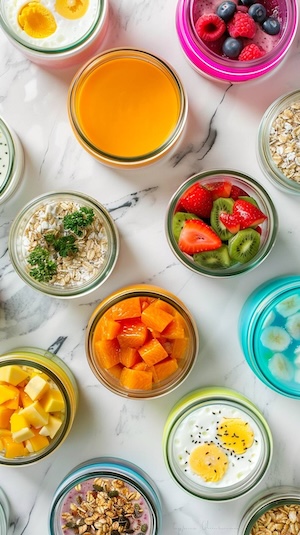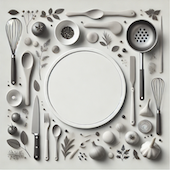Best Cereal for PCOS: Brands Ranked & Reviewed
Discover the best cereal for PCOS with our expert rankings. Compare brands, check ingredients, and find PCOS friendly cereal that supports hormonal balance.
Not only can you make cake balls and turn them into cake pops, but you can also mold them into other shapes using a small metal cookie cutter. For these cupcake pops, use a flower-shaped cookie cutter. Take them to the next level of cuteness by using more
Transform your health with tailored 7-day meal plans designed specifically for PCOS management. Just $7/month or $59/year.
Get it now →1 box cake mix
1 container ready-made frosting
32 oz. chocolate candy coating
16 oz. pink candy coating
48 paper lollipop sticks
tsp. M&M’s or similarly shaped candy
Sprinkles
Styrofoam block
In a 9- by 13-inch cake pan, bake the cake as directed on the box. Let cool completely.
Once the cake is baked, get organized and set aside plenty of time (a few hours) to crumble, roll, shape, dip, and decorate 4 dozen cupcake pops.
Crumble the cooled cake into a large mixing bowl. The texture of the cake causes it to crumble easily. To make crumbling easier, first cut the baked 9- by 13-inch cake into 4 equal sections. Remove a section from the pan, break it in half, and rub the two pieces together over a large bowl, making sure to crumble any large pieces that fall off. You can also use a fork to break any larger pieces of cake apart. Repeat with each section until the entire cake is crumbled into a fine texture. If you have large pieces mixed in, the cake balls may turn out lumpy and bumpy. You should not see any large pieces of cake.
Add three-quarters of the container of frosting. (You will not need the remaining frosting.) Mix it into the crumbled cake, using the back of a large spoon, until thoroughly combined. If you use the entire container, the cake balls will be too moist.
The mixture should be moist enough to roll into 1 1/2-inch balls and still hold a round shape. After rolling the cake balls by hand, place them on a wax paper–covered baking sheet.
Cover with plastic wrap and chill for several hours in the refrigerator, or place in the freezer for about 15 minutes. You want the balls to be firm but not frozen.
Remove the baking sheet from the refrigerator or freezer and begin shaping the cake balls into cupcakes. Take a chilled ball and roll it into a cylinder shape. Then slide it into the flower-shaped cookie cutter. The cake mixture should fill the entire cutter, with any excess forming a mounded cupcake top on one side. You can use your thumb to keep the shape flat on one side, allowing the rest to form a mound on the other. When you have the shape the way you like it, gently push the shaped cupcake out of the cutter from the bottom. If the mixture is still firm enough, you should also be able to gently pull it out by holding the top mounded side.
Place the cupcake-shaped cake ball, right-side up, back on the wax paper–covered baking sheet. Continue with the remaining cake balls.
Once the balls are all shaped into cupcakes, return them to the freezer for 5 to 10 minutes to keep them firm.
Place the chocolate candy coating in a deep, microwave-safe plastic bowl. These bowls make it easier to dip the cupcake bottoms completely in candy coating while holding the bowl without burning your fingers. (It is usually easier to work with about 16 ounces of coating at a time.)
Melt the chocolate candy coating, following the instructions on the package. Microwave on medium power for 30 seconds at a time, stirring with a spoon in between. You can also use a double boiler. Either way, make sure you do not overheat the coating.
Take a few cupcake-shaped cake balls at a time out of the freezer to work with. Transfer the rest to the refrigerator at this point, so they stay firm but do not freeze.
One at a time, take a cupcake-shaped cake ball and, holding it by the mounded top, dip the bottom into the melted chocolate candy coating — just to the point where the mounded shape starts. Remove it from the chocolate, turn it upside down, and swirl your hand in a circular motion. This will cause any excess chocolate coating to slide down. When the coating reaches the bottom of the mounded cupcake top shape, you can stop. Have a dish towel handy to wipe off your fingertips, as it is highly likely that you will get some coating on them. Don't use water to rinse your hands, as getting water in the coating can make it unusable.
Place the half-coated cupcake shape on the second wax paper–covered baking sheet, chocolate-candy-coating-side up, mounded side down. Immediately dip about 1/2 inch of the tip of a lollipop stick into the melted candy coating, and insert the stick straight into the flat, chocolate-coated bottom of the cupcake while the chocolate is still wet. Push it no more than halfway through. Continue with the rest of the cupcake-shaped cake balls. Allow the chocolate to dry completely.
Melt the pink candy coating in the same way as the chocolate.
Holding its lollipop stick, dip the top of a cupcake in the melted pink candy coating. It should completely cover the rest of the exposed cupcake and meet the edge of the chocolate coating.
Remove the cupcake pop from the coating and turn it right-side up. If the coating is too hot, it will start to drip down the sides. If this happens, let the coating sit for a few minutes to cool and start to thicken. Then when you dip the tops, the coating will stay in place.
While the coating is still wet, use a toothpick to touch up any areas the coating may not have covered. Then place 1 M&M (M-side down) on the top and add sprinkles for decoration.
Place the cupcake pop in a prepared Styrofoam block to dry completely. Repeat with the remaining cupcake pops.
Store the cupcake pops in an airtight container on the counter or in the refrigerator for several days. You can also cover them in small treat bags, tied with a ribbon, and leave them in the Styrofoam block on the counter.

You know the drill: Alarm goes off. You hit snooze. Rush around frantically. Skip breakfast AGAIN because there's no time. By 10am, you're hangry, your blood sugar is all over the place, and your PCOS symptoms are already acting up.
Sound familiar?
Finally – a meal prep system designed specifically for women with PCOS who refuse to let chaotic mornings derail their health goals.
In just ONE hour on Sunday, you can transform your entire week:
"I went from skipping breakfast 4 days a week to having delicious, hormone-supporting meals ready every morning. My energy is more stable and my cravings have disappeared!"
– Sarah M.
Stop letting chaotic mornings control your health.
Get your hormone-happy mornings starting this Sunday.
→ Get Your 60-Minute Solution Now
Transform your health with tailored 7-day meal plans designed specifically for PCOS management. Just $7/month or $59/year.
Get it now →Serving Size: 48
| Amount Per ONE Serving | ||
|---|---|---|
| Calories 0 kcal | ||
| Fat 0 g | ||
| Carbohydrate 0 g | ||
| Protein 0 g | ||
💡 Introducing the 10/10 PCOS Solution:
Ten Delicious Crockpot Recipes that take just 10 minutes to prep!
Say goodbye to hours in the kitchen and hello to clean, PCOS-friendly meals made effortlessly.
👉 Click here to grab your 10/10 PCOS Solution today! Try The 10/10 PCOS Solution: Ten Crockpot Recipes That Take Just Ten Minutes to Prep
Managing PCOS can be challenging, but you don't have to do it alone. Join our supportive community to connect with others who understand what you're going through, share tips, and get encouragement. Here's how you can get involved:
Subscribe to our Newsletter: Receive PCOS-friendly recipes, tips, research updates, and more delivered straight to your inbox. Stay informed and empowered with the latest information and support.
Join our Telegram Channel: Stay updated with the latest tips and advice on managing PCOS.
Follow PCOS Meal Planner on Facebook: Engage with our community, participate in discussions, and get support from others.
Break the cycle with the PCOS Meal Planner - your personalized guide to eating better, feeling better, and managing PCOS symptoms. Take control today!

Forget the frustrating cycle of weight loss attempts, endless medications, and living in discomfort. Introducing the PCOS Meal Planner. A meal planning guide that goes beyond temporary fixes to offer a comprehensive strategy, empowering you to ignite a transformation towards lasting health and happiness. Step into a world where you control your PCOS, not the other way around.
Unlock Your PCOS Freedom Now.
Discover the best cereal for PCOS with our expert rankings. Compare brands, check ingredients, and find PCOS friendly cereal that supports hormonal balance.
Learn how to transition away from fruit when starting a ketogenic diet for PCOS. Discover gradual strategies, fruit alternatives, and practical tips for success.
Discover 5 delicious PCOS banana bread recipes with low-glycemic ingredients. Learn how to make hormone-friendly banana bread that supports blood sugar balance.
Creatine for women with PCOS explained simply. Learn safety, benefits, hormone effects, tips, and how creatine may support PCOS symptoms naturally.
Complete PCOS diet plan with foods to eat, foods to avoid, meal timing, and real results. Learn the science-backed approach to managing PCOS through diet, with 7-day meal plan, grocery list, and step-by-step implementation guide. Based on clinical research and real patient outcomes.
Complete guide to ordering at Wendy's with PCOS. Discover the best protein-focused meals, what to skip, and how to customize orders to keep blood sugar stable. Learn which burgers, salads, and sides work for PCOS, plus complete macros for every menu item and smart swaps to avoid insulin spikes.
Complete guide to ordering at Burger King with PCOS. Discover the best protein-focused meals, what to skip, and how to customize orders to keep blood sugar stable. Learn which burgers, salads, and sides work for PCOS, plus complete macros for every menu item and smart swaps to avoid insulin spikes.
Discover 30+ delicious PCOS-friendly smoothie recipes that stabilize blood sugar and support hormones. Each recipe includes protein macros, glycemic load, and hormone-balancing ingredients. Find breakfast smoothies, post-workout options, green smoothies, and dessert alternatives - all designed to prevent insulin spikes while satisfying cravings.
Discover the best supplements for PCOS backed by clinical research. Learn which supplements improve insulin resistance, reduce androgens, support ovulation, and balance hormones. Complete guide with dosages, timing, brands, and what to avoid. Evidence-based recommendations for inositol, vitamin D, omega-3, berberine, and more.